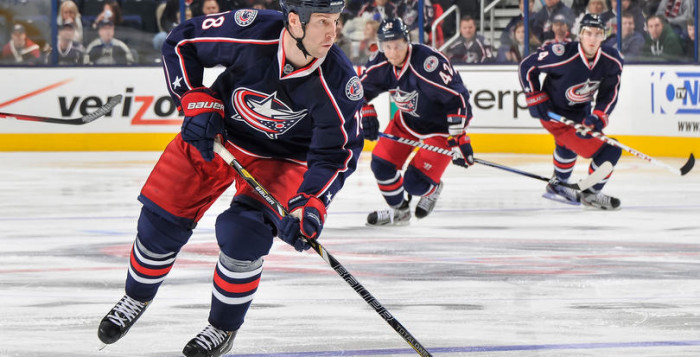How Do You Solve a Problem Like Columbus?
(photo credit: bluejackets.nhl.com)
Spoiler alert: I don’t actually know the answer to this question. (To be honest, I’m not sure that Todd Richards or Jarmo Kekalainen know the answer to this question.) CBJ is by turns remarkable and kind of embarrassing, like a Seth Rogan movie or your math-savant geek cousin trying to make it through his first date. They’re the kind of team that can’t seem to find a happy middle ground of play that falls between “GAME SEVEN OF THE STANLEY CUP PLAYOFFS” and “schoolyard shinny with kids you babysit.”
The problem is that playing like it’s the Stanley Cup Finals isn’t sustainable over an entire season and apparently the kids we babysit are like 6’5″ and have a mean streak a mile wide.
Every time you read analysis about CBJ, there are certain buzzwords that are going to come up: young team, consistency, injury. Similar buzzwords that also come up with Edmonton, actually; not surprising, given that Edmonton is Crown Champion of Unrealized Potential. Those are buzzwords that come up because those are real issues that we have. After all, clichés are clichés because there’s a least of grain of truth in them.
But those words are the “what.” They don’t really account for the “why.”
THE STATE OF THINGS:
(source)
Rank: 23rd Overall, 7th in the Metropolitan Division
Points: 46
Win Percentage: 0.511%
Penalty Kill Percentage: 79.6%
Shot Differential: -3
Team Shooting Percentage: 9.79%
There are obviously a lot of statistics to choose from and look at, and the best analysis is going to take into account most or all of them (consider this parenthetical the placeholder for my usual rant against the value of plus/minus). But let’s just look at these for now, since I think they’re pretty telling as a snapshot.
23rd out of 30 is a fairly discouraging rank, on the surface of things; luckily, that’s really only valuable to think about in terms of Stanley Cup match-ups, since it’s not going to have too drastic effect on actual playoff chances. Even still, 7 out of 8 isn’t exactly a huge turn around. But, as in all areas, Columbus isn’t exactly what it seems–or rather, it isn’t necessarily what it seems, because some games we certainly play like we deserve 7th.
If, however, we take a look at, say, Philadelphia, who currently ranks 3rd in the Metropolitan division, we’re not quite as badly off as the numbers may suggest.
The Flyers have 23 wins to CBJ’s 21; we have the same number of games that went into OT. At home, CBJ is 10-9-2, and away they’re 11-11-2; at home, Philly is 12-8-0 and away they’re 11-10-4. Philly has a -5 shot differential to CBJ’s -3 (both of whom kind of look like Hodor standing next to Cersei Lannister when we look at the Pens’ +40).
Basically, the issue is that our numbers aren’t terrible. Some of them aren’t great. It’s clear that when CBJ melts down, they melt down hard. I’m talking The Secret Life of Alex Mack levels of viscosity. But, ultimately, that’s a reflection of their mental game, not their . . . actual game.
Of course, the mental/physical divide doesn’t actually matter all that much when you get down to it. Points are points, wins are wins, and losses are losses. But it is, at the very least, a comforting differential. It’s the kind of potential that’s not based on beautiful hopes and dreams, but actual numbers. Take, for example, the shooting percentage, which is 6th in the NHL (11th with the differential). 9.79% of our shots on goal are successful–compare that, again to Philly, which comes in at 8.72% (16th overall). That’s not a bad place to be.
The conclusion here seems a little obvious and a lot like nobody needed me to break down the numbers to discover the secret: take more shots on goal. Depend less on Bob and McElhinney. Win more? Is that valuable advice? These are all conquerable problems, most of which can be solved by doing exactly what CBJ has done over the course of the last three games, which is sticking with their system and focusing on more of a transition game than an open one. As often happens in sports, winning grows confidence, improves gameplay, builds morale. Winning makes it easier to win.
When the problem lies with meltdowns, not actual gameplay, the solution rarely lies in the numbers.
So: how do you solve a problem like Columbus? Kekalainen, Richards and I aren’t exactly sure, but if anyone has the name of a captain nanny they could recommend, at this point we’re really open to anything.














